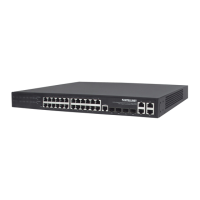are a complicated and complex subject and must be fully researched and understood. It is possible to cause
serious degradation to network performance if the Spanning Tree is incorrectly congured. Please read the
following before making any changes from the default values.
The Switch STP performs the following functions:
• Creates a single spanning tree from any combination of switching or bridging elements.
• Creates multiple spanning trees – from any combination of ports contained within a single switch, in
user specied groups.
• Automatically recongures the spanning tree to compensate for the failure, addition or removal of
any element in the tree.
• Recongures the spanning tree without operator intervention.
Bridge Protocol Data Units
For STP to arrive at a stable network topology, the following information is used:
• The unique switch identier
• The path cost to the root associated with each switch port
• The port identier
STP communicates between switches on the network using Bridge Protocol Data Units (BPDUs). Each BPDU
contains the following information:
• The unique identier of the switch that the transmitting switch currently believes is the root switch
• The path cost to the root from the transmitting port
• The port identier of the transmitting port
The switch sends BPDUs to communicate and construct the spanning-tree topology. All switches connected
to the LAN on which the packet is transmitted will receive the BPDU. BPDUs are not directly forwarded by the
switch, but the receiving switch uses the information in the frame to calculate a BPDU, and, if the topology
changes, initiates a BPDU transmission.
The communication between switches via BPDUs results in the following:
• One switch is elected as the root switch
• The shortest distance to the root switch is calculated for each switch
• A designated switch is selected. This is the switch closest to the root switch through which packets
will be forwarded to the root.
• A port for each switch is selected. This is the port providing the best path from the switch to the root
switch.
• Ports included in the STP are selected.
Creating a Stable STP Topology
If all switches have STP enabled with default settings, the switch with the lowest MAC address in the network
will become the root switch. By increasing the priority (lowering the priority number) of the best switch, STP
can be forced to select the best switch as the root switch. When STP is enabled using the default parameters,
the path between source and destination stations in a switched network might not be ideal. For instance,
connecting higher-speed links to a port that has a higher number than the current root port can cause a
root-port change.
STP Port States
BPDUs take some time to pass through a network. This propagation delay can result in topology changes
where a port that transitioned directly from a Blocking state to a Forwarding state could create temporary
data loops. Ports must wait for new network topology information to propagate throughout the network
before starting to forward packets. They must also wait for the packet lifetime to expire for BPDU packets
that were forwarded based on the old topology. The forward delay timer is used to allow the network
topology to stabilize after a topology change. In addition, STP species a series of states a port must
transition through to further ensure that a stable network topology is created after a topology change.
Each port on a switch using STP exists is in one of the following ve states:

